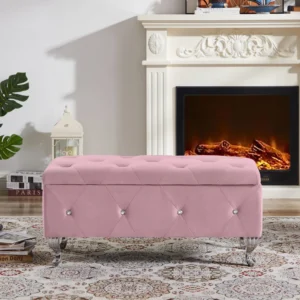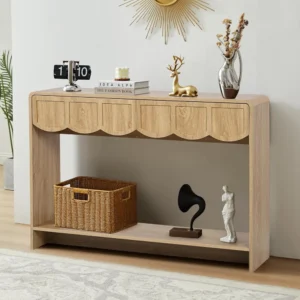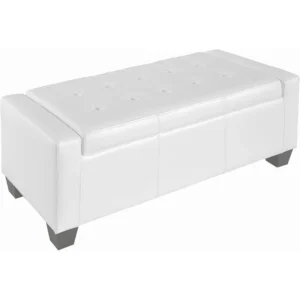Understanding the Entryway Challenge: Combining Functionality and Style in Limited Space
Your entryway sets the first impression of your home while serving as a critical transition zone between the outside world and your living space. This dual role makes it one of the hardest-working areas in any home, yet many entryways suffer from a common challenge: limited space. In modern homes, entryways often measure just 8-10 square feet, creating a significant organizational challenge.
The limitations of a small entryway quickly become apparent in daily life. Keys get misplaced, shoes pile up, bags end up on the floor, and there’s nowhere to sit while putting on or removing footwear. Without proper organization, these spaces quickly become cluttered collection points for everyday items, creating a stressful arrival and departure experience.
The lack of designated spots for daily essentials combined with minimal floor space creates a frustrating cycle of disorder that many homeowners struggle to break. Recent interior design surveys consistently show that entryway organization ranks among the top concerns for homeowners, particularly those in apartments, townhomes, and newer construction with smaller footprints.
Space-saving entryway seating presents an elegant solution to these challenges. When thoughtfully selected, the right seating option can provide a comfortable spot to prepare for coming and going while simultaneously addressing storage needs and enhancing your home’s aesthetic appeal. These multi-functional pieces transform entryway space-saving benches into organizational powerhouses without sacrificing style or requiring extensive square footage.
In this comprehensive guide, we’ll explore various types of space-saving seating solutions designed specifically for compact entryways, from multifunctional storage benches to wall-mounted options that completely free up floor space. By incorporating these smart solutions, you can create a welcoming, functional, and decluttered functional entryway that sets the perfect tone for your home.
Essential Factors to Consider Before Selecting Space-Saving Entryway Seating
Before diving into specific seating options, taking time to assess your unique space and needs will ensure you select the perfect solution. A thoughtful approach to measurement and functionality requirements will prevent costly mistakes and disappointment.
Precise measurements: Always measure your available space before shopping, including width, depth, and height considerations. Maintain a minimum walkway clearance of 36 inches (91 cm) to ensure comfortable passage. Measure twice to avoid the frustration of returns.
Primary usage patterns: Consider how your entryway seating will be used most often. Will it primarily serve as occasional seating for putting on shoes, or will people regularly sit there for longer periods? More frequent use demands more comfortable designs with proper back support.
Storage needs analysis: Evaluate what items typically accumulate in your entryway and need storage. Shoes, bags, seasonal accessories, pet supplies, and children’s items all require different storage solutions. The complete guide choosing compact bench can help you identify the right storage configuration for your specific needs.
Material considerations: Entryway furniture endures significant wear and tear. Durable materials like solid wood, metal frames, and performance fabrics stand up better to daily use. Consider how easy materials are to clean, particularly if you have children or pets.
Style compatibility: Your entryway sets the tone for your entire home. Select seating that complements your existing decor style, whether it’s farmhouse, mid-century modern, industrial, or traditional. The most functional piece will feel like a mistake if it clashes with your overall aesthetic.
Budget expectations: Quality entryway furniture represents an investment in both organization and home value. While budget considerations are important, prioritize quality construction for pieces that will endure daily use. Remember that multi-functional pieces often provide better value by solving several needs with a single purchase.
By carefully evaluating these factors before shopping, you’ll be equipped to select entryway seating that truly serves your space and lifestyle. The perfect piece balances compact dimensions with the functionality your household requires while enhancing your home’s style.
Multifunctional Storage Benches: The Entryway Workhorse
Storage benches represent the quintessential space-saving solution for entryways, combining comfortable seating with hidden storage in a relatively compact footprint. These versatile pieces serve as the foundation of an organized entryway system by providing both a place to sit and a designated home for everyday items.
The storage mechanism of your bench significantly impacts its functionality and convenience. Lift-top designs offer the most generous storage capacity, with the entire seat lifting to reveal a large compartment ideal for seasonal items, extra shoes, or bulky accessories. Drawer configurations provide easier access without needing to remove items from the seating surface, making them perfect for frequently used items like gloves or dog leashes. Cubby-style benches with open compartments or baskets offer visible storage with the advantage of ventilation for damp items.
Size variations abound to accommodate different entryway dimensions. Compact models measuring 30-36 inches (76-91 cm) wide work well in narrow spaces, while fuller-width options extending to 48 inches (122 cm) provide more generous seating and storage capacity. Depth is equally important—look for models between 12-16 inches (30-41 cm) deep that provide comfortable seating without protruding too far into walkways.
Material selection impacts both aesthetics and durability. Solid wood construction offers timeless appeal and excellent durability but may carry a higher price point. Engineered wood provides a more budget-friendly alternative while still offering reasonable longevity. Metal frames combined with upholstered seats strike a balance between industrial style and comfort. Regardless of material, verify weight capacity—most quality benches support between 250-400 pounds (113-181 kg).
Pros and Cons of Storage Benches:
* Pros: Maximum functionality in a single piece, variety of storage configurations, comfortable seating, wide style selection
* Cons: Require some floor space, heavier and less movable than other options, top-opening models need clearance space
For optimal placement, position your storage bench against the longest available wall in your entryway, leaving sufficient clearance for doors to swing fully open. Add cushions or pillows to enhance comfort and introduce color or pattern. Consider pairing with wall-mounted hooks above to create a complete entryway system without consuming additional floor space.
Our entryway bench storage collection offers various sizes and configurations designed specifically for maximizing function in limited spaces.
Slim-Profile Shoe Storage Benches for Organized Entryways
When footwear clutter represents your primary entryway challenge, specialized shoe storage benches offer targeted solutions that keep shoes organized while providing convenient seating. These purpose-built pieces are designed with slimmer profiles and specialized compartments that efficiently accommodate multiple pairs of shoes without dominating the entryway.
Open cubby designs provide the most accessible shoe storage with the added benefit of airflow to help dry damp footwear and prevent odors. These visible compartments encourage family members to actually use the storage system rather than dropping shoes on the floor. For those who prefer a neater appearance, concealed shoe storage benches feature cabinet doors, tilt-out compartments, or drawers that hide footwear from view while maintaining easy access. Many designs incorporate both visible and concealed storage to accommodate different types of shoes.
Proper ventilation remains an important consideration for any shoe storage solution. Look for designs with slatted shelving, open backs, or perforated panels that allow air circulation. This feature is particularly valuable in regions with frequent rain or snow, where wet shoes are a regular concern. Most slim-profile shoe benches accommodate 6-12 pairs of adult shoes, with dimensions averaging 24-36 inches (61-91 cm) wide and just 12-14 inches (30-36 cm) deep—significantly more compact than standard storage benches.
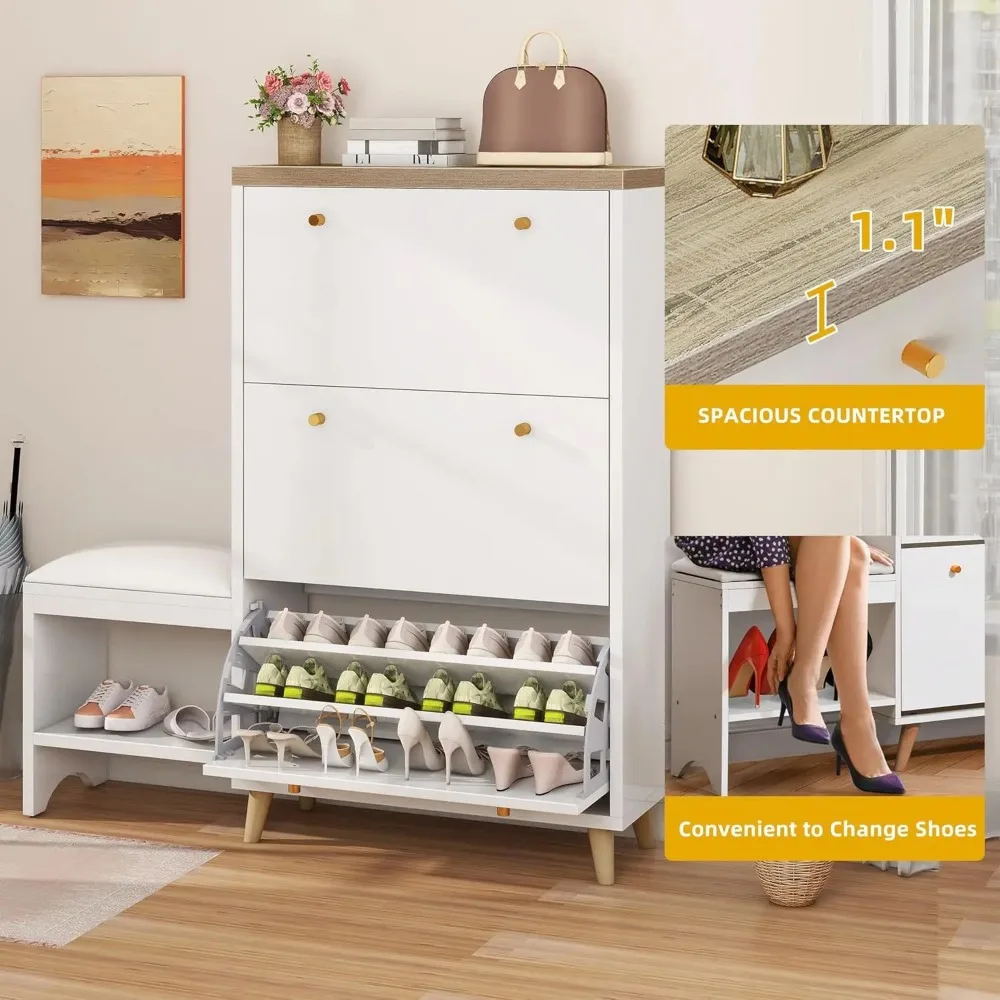
For maintenance, look for shoe compartments with removable shelves or washable liners that simplify cleaning. Models with wipeable surfaces and protective finishes resist staining from dirty shoes and wet boots. Some designs incorporate specific boot compartments with taller clearance or drip trays to contain melting snow or mud.
Key features to seek in a quality shoe storage bench include:
* Sturdy construction that withstands frequent use
* Compartment sizes that accommodate your family’s typical footwear
* Comfortable seat height (typically 17-19 inches/43-48 cm)
* Easy-to-clean materials and surfaces
* Compact depth to minimize protrusion into walkways
Our shoe storage bench entryway options provide specialized solutions for controlling footwear clutter while maximizing seating in compact spaces.
Space-Maximizing Hall Trees: Vertical Solutions for Complete Organization
Hall trees represent the ultimate all-in-one entryway solution by utilizing vertical space to combine seating, storage, and hanging options in a single unified piece. These comprehensive units provide organized landing spots for virtually every item that enters or leaves your home, from coats and bags to shoes and accessories.
Compact and slim-line hall tree designs have evolved specifically to accommodate smaller entryways without sacrificing functionality. Modern versions often measure just 24-36 inches (61-91 cm) wide while incorporating full-height storage that extends 6-7 feet (183-213 cm) tall. This vertical orientation makes them particularly valuable in entryways with limited floor space but available wall height. Corner hall trees offer even greater space efficiency by utilizing often-wasted corner space with angled designs that fit snugly where two walls meet.
The key components that make hall trees so effective include coat hooks (typically 4-8 hooks depending on size), shoe storage shelves or cubbies, seating benches, and often additional features like mirrors, shelves for accessories, or even mail organizers. Premium models may incorporate closed cabinets, drawers, or specialized compartments for umbrellas, pet supplies, or charging stations for electronics.
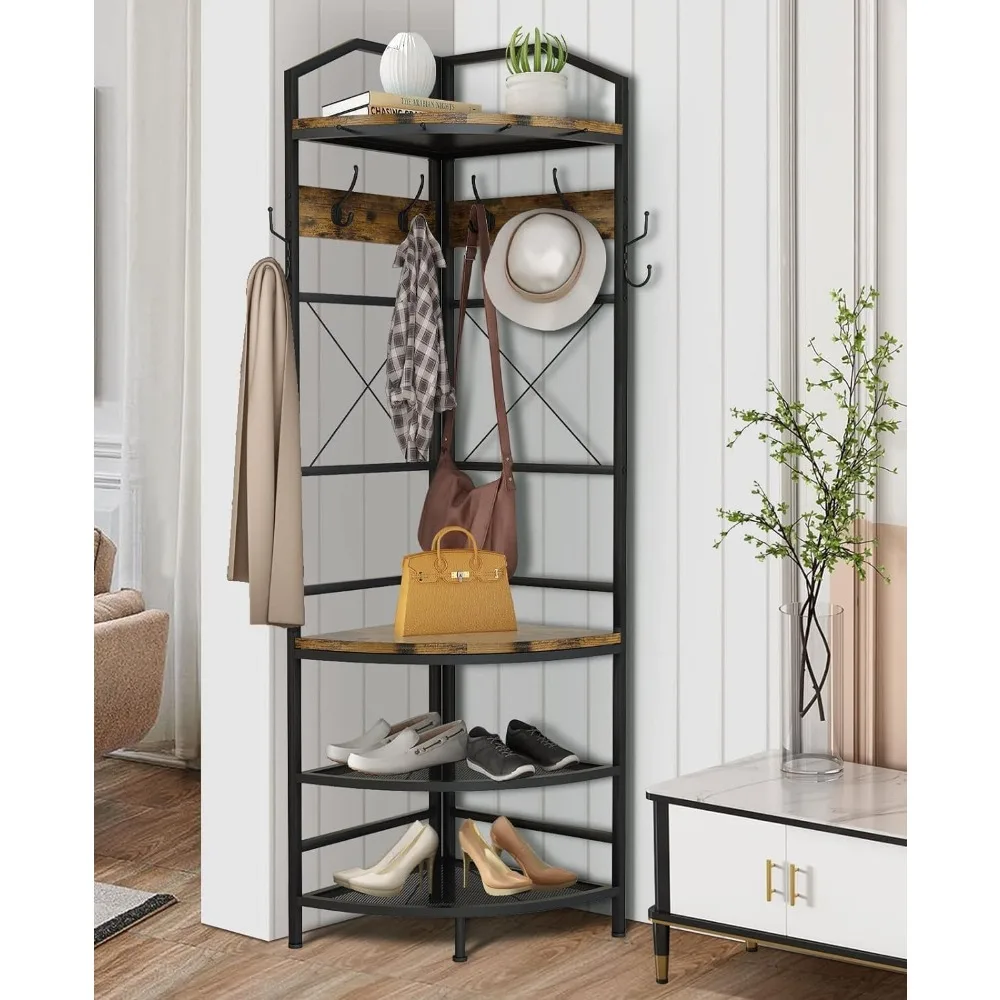
When considering installation, verify that your hall tree includes proper stability features, particularly for taller models. Many designs require secure wall mounting for safety, especially in households with children who might climb or pull on the unit. Confirm that your wall construction can support the recommended mounting hardware and anticipated weight load.
The greatest benefit of hall trees is their comprehensive approach to entryway organization. Rather than purchasing separate pieces for each function (bench, coat rack, shoe storage), a hall tree consolidates these elements into a cohesive unit that often occupies less total floor space than individual pieces would require. This integration creates a designated “drop zone” that naturally encourages family members to put items in their proper places.
Our corner hall tree collection includes space-efficient designs specifically engineered for smaller entryways. These versatile units provide complete organization systems without overwhelming limited spaces. For additional style options, explore our stylish entryway trees bench seating guide that showcases different design approaches.
Compact Ottomans and Poufs: Flexible Seating Solutions
When maximum versatility is required for truly tight spaces, compact ottomans and poufs offer unmatched flexibility. These small-scale seating options can be easily repositioned as needed, tucked away when not in use, and even serve multiple functions throughout your home.
Storage ottomans designed specifically for entryways combine comfortable seating with hidden compartments in a footprint measuring just 16-20 inches (41-51 cm) in diameter or width. Unlike larger benches, these compact options can be positioned virtually anywhere space permits—against walls, beside console tables, or even in corners. The lifting lids provide surprisingly generous storage for items like winter accessories, pet supplies, or reusable shopping bags that need a dedicated home near the door.
For the ultimate in space efficiency, consider nesting ottoman sets that include two or three graduated-size pieces that stack within each other when not needed. These clever sets can be separated to provide seating for multiple people when guests arrive, then compactly stored when not in use. Some designs even incorporate different heights to serve as both seating and side tables simultaneously.
Material selection becomes particularly important for these versatile pieces since they often receive more direct contact than benches with backs. Look for durable upholstery options like leather, performance fabrics, or indoor/outdoor materials that resist staining and withstand frequent use. Weight capacity typically ranges from 200-300 pounds (91-136 kg), making them suitable for most adults despite their compact size.
The true advantage of ottomans and poufs lies in their multi-room versatility. When not needed in the entryway, these pieces can serve as:
* Extra seating in living spaces when entertaining
* Footrests in family rooms
* Nightstands in bedrooms
* Step stools for children (with appropriate weight ratings)
* Side tables when topped with decorative trays
This flexibility makes them particularly valuable in small homes, apartments, or spaces with fluctuating needs. Our small entryway bench collection includes various compact ottomans designed specifically for limited-space applications.
Minimalist Entryway Stools and Accent Seats
For the most space-constrained entryways, individual stools and accent seats provide essential functionality with the smallest possible footprint. These minimalist options deliver the core benefit of having somewhere to sit while putting on shoes without the additional bulk of storage components or backs.
Single stools with dimensions as compact as 12-18 inches (30-46 cm) in diameter can fit in virtually any entryway, no matter how limited the space. Their backless design allows them to be completely tucked under console tables when not in use, effectively disappearing from the floor plan. For even greater space efficiency, folding stools can be collapsed and stored inside closets or behind doors, occupying zero floor space when not actively being used.
The visual lightness of these minimal pieces makes them particularly valuable in entryways that already feel cramped. Their small scale and often leggy construction creates less visual weight than solid storage pieces, helping to maintain an open, airy feeling in tight quarters. Many designs incorporate interesting materials, textures, or shapes that allow them to serve as decorative accents rather than purely functional pieces.
When selecting an entryway stool, pay particular attention to height. For comfortable shoe changing, look for options between 17-19 inches (43-48 cm) high—standard seating height for most adults. For households with elderly members, slightly higher seats (19-21 inches/48-53 cm) may provide easier transitions from sitting to standing positions.
Strategic placement maximizes the functionality of these small-scale pieces:
* Beside the door for quick sit-downs when entering or leaving
* Under console tables to create a vanishing seating option
* In corners that might otherwise be wasted space
* Paired with wall-mounted hooks to create a mini landing zone
* As supplementary seating that complements a main bench
For additional creative ways to incorporate minimal seating, our space-saving entryway ideas guide offers innovative approaches for even the most challenging spaces.
Wall-Mounted Seating: Maximizing Floor Space
When floor space is at an absolute premium, wall-mounted seating solutions offer the ultimate space-saving advantage by completely eliminating ground contact. These innovative designs attach directly to wall studs, creating functional seating that appears to float within the space.
Fold-down seating represents the most dramatic space-saving option, with hinged designs that fold flat against the wall when not in use, projecting just 2-3 inches (5-8 cm). When needed, these seats fold down to provide standard seating depth and comfort. Advanced mechanisms ensure smooth operation and secure positioning in both open and closed positions. Some models even incorporate storage compartments behind the seat that become accessible when folded up.
Floating bench designs maintain a fixed position but eliminate legs by mounting securely to wall studs. This approach creates visual spaciousness by keeping the floor clear beneath the bench, making cleaning easier and creating the perception of a larger area. Many floating benches incorporate minimal supports that provide stability while maintaining their sleek appearance.
Weight capacity represents a critical consideration for wall-mounted options. Quality designs typically support 200-300 pounds (91-136 kg) when properly installed into wall studs. Installation requirements must be carefully followed, including using appropriate hardware and ensuring proper stud location. Most models require at least two sturdy mounting points connected directly to structural supports within the wall.
Beyond their space-saving benefits, wall-mounted seating offers distinct advantages for cleaning and maintenance. The clear floor space beneath makes vacuum cleaning effortless compared to moving heavy furniture. This feature proves particularly valuable in entryways that accumulate dirt, snow, or debris.
Available in various materials including wood, metal, and composite options, wall-mounted seating can complement any design aesthetic from industrial to farmhouse. Our narrow entryway bench collection includes several floating options designed specifically for tight spaces.
Creative and Custom Space-Saving Seating Ideas
Sometimes standard furniture solutions don’t perfectly fit unusual entryway configurations. In these cases, creative approaches and custom solutions can transform challenging spaces into functional, welcoming entrances with effective seating options.
Corner seating represents one of the most underutilized opportunities in small entryways. Custom corner benches or triangular stools can activate these often-wasted spaces, potentially increasing usable seating area by up to 30% compared to standard linear arrangements. L-shaped bench designs that wrap around corners provide even more seating while conforming to the room’s natural architecture.
Repurposed furniture offers both sustainability and unique style possibilities. Consider these creative conversions:
* Low bookcases topped with cushions create window-seat style seating with built-in storage
* Vintage trunks or chests provide hidden storage with character and history
* Kitchen island stools can double as entryway seating when not needed elsewhere
* Narrow dining benches can find new purpose in entryways when no longer needed at tables
* Garden benches brought indoors add rustic charm while providing durable seating
For permanent solutions that maximize every inch, built-in seating constructed during renovation offers custom-fitted options that utilize unusual dimensions or awkward spaces. While requiring more initial investment, built-ins can incorporate specific storage configurations tailored exactly to your household’s needs. They can be designed to fit around architectural features like radiators, columns, or uneven walls that would make standard furniture placement difficult.
DIY modifications to standard furniture pieces represent an approachable middle ground between custom work and off-the-shelf options. Simple adjustments like cutting down the depth of a standard bench, adding casters for mobility, or incorporating cushion storage can personalize basic pieces to better serve your specific space constraints and functional requirements.
When considering custom solutions, factor in not just the initial cost but the long-term value of having perfectly fitted furniture that maximizes your specific space. Our guide to organize small entryway bench offers additional tips for customizing organization systems around non-standard seating arrangements.
Styling and Optimizing Your Space-Saving Entryway Seating
Once you’ve selected the perfect space-saving seating solution, thoughtful styling and organization will enhance both its functionality and aesthetic appeal. Small details make significant differences in how efficiently these pieces serve your daily routines.
Comfort enhancements transform basic seating into inviting spots while adding visual interest. Weather-resistant cushions with removable, washable covers prove practical for entryway use where dirt and moisture are common challenges. Select materials with stain-resistant properties in patterns or darker colors that conceal inevitable marks. Textural elements like throw pillows or seat pads can be swapped seasonally to refresh the space with minimal investment.
Complementary entryway elements work in concert with your seating to create a complete functional zone:
* Wall-mounted mirrors positioned above seating create the illusion of expanded space while providing a last-minute appearance check
* Slim lighting fixtures like sconces or pendant lights ensure the area is well-illuminated without consuming precious surface space
* Floating shelves installed above benches provide landing spots for mail, keys, and decorative elements
* Narrow console tables paired with compact stools create a more substantial entryway presence in larger openings
Coat Rack Shoe Bench, Corner Entryway Bench, Corner Hall Tree, Shoe Bench for Entryway
$313.58 Select options This product has multiple variants. The options may be chosen on the product pageShoe Storage Bench for Entryway
$459.02 Select options This product has multiple variants. The options may be chosen on the product pageEntryway Bench with Cushion, Small Entryway Bench
$466.79 Select options This product has multiple variants. The options may be chosen on the product page- Price range: $785.40 through $897.63 Select options This product has multiple variants. The options may be chosen on the product page
Entryway Bench with Storage, Shoe Bench for Entryway
$487.70 Select options This product has multiple variants. The options may be chosen on the product pageFarmhouse Entryway Bench, Narrow Entryway Bench, Shoe Bench for Entryway, Shoe Shelf Bench
$482.78 Select options This product has multiple variants. The options may be chosen on the product page
Maintaining organization requires consistent habits and sometimes creative approaches. Establish a simple system that every household member can follow, using labeled baskets, designated hooks, or specific drawers for each person’s belongings. Implementing a “one in, one out” policy for seasonal items helps prevent accumulation and overflow. Regular purging of unused items keeps even the smallest storage systems functioning effectively.
Color selection significantly impacts perceived spaciousness. Lighter tones generally make spaces feel more open, while darker pieces can serve as anchors in floating layouts. Consider selecting seating in a color that closely matches your wall color for a built-in effect that visually recedes. Alternatively, use a statement piece in a contrasting color to create a focal point that draws attention away from the room’s small dimensions.
Our smart entryway storage seating solutions guide provides additional styling approaches that balance form and function in compact entry spaces.
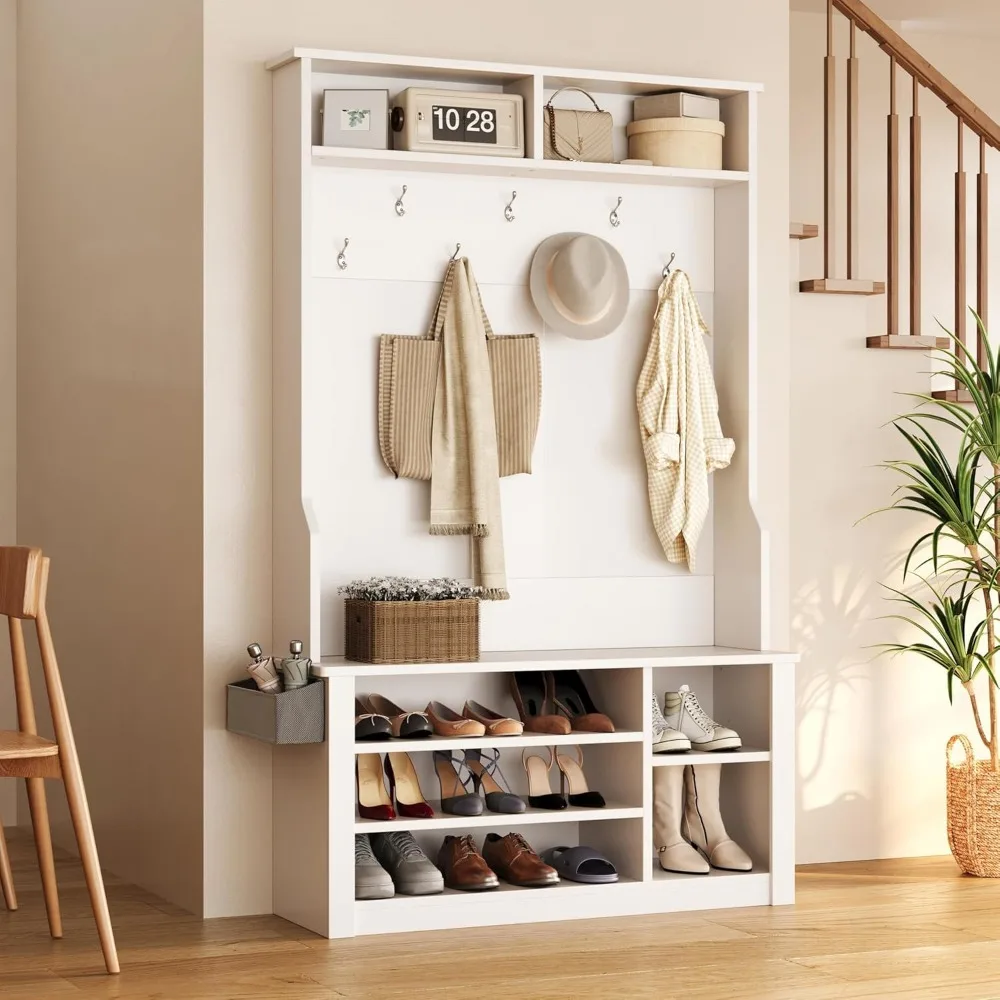
Finding Your Perfect Match: A Decision Guide
With so many space-saving seating options available, selecting the ideal solution for your specific needs can feel overwhelming. This simplified reference guide matches common entryway challenges with their most effective solutions:
| Primary Need | Best Seating Solution | Key Benefit |
|---|---|---|
| Maximum storage | Storage bench with lift top | Largest hidden storage volume |
| Shoe organization | Specialized shoe storage bench | Ventilated, designated shoe spaces |
| Complete organization system | Hall tree or corner hall tree | All-in-one solution with hooks and multiple storage types |
| Ultimate flexibility | Storage ottoman or nesting set | Movable, multi-purpose, can be used in other rooms |
| Absolute minimum footprint | Folding stool or wall-mounted seat | Zero floor space when not in use |
| Awkward or unusual space | Custom corner seating or repurposed furniture | Tailored to specific spatial challenges |
Remember that the most important consideration is accurate measurement of your available space before making any purchase. Even the most beautiful, functional piece will become a frustration if it doesn’t fit properly or impedes natural movement through your entryway.
When balancing features with budget, prioritize quality construction for pieces that will endure daily use and frequent weight-bearing. Multi-functional pieces often provide better long-term value by solving several needs with a single purchase. Our best small benches entryways guide offers specific recommendations across various price points.
FAQ: Common Questions About Space-Saving Entryway Seating
Q: How much weight can wall-mounted seating typically support?
A: Quality wall-mounted seating properly installed into wall studs can typically support between 200-300 pounds (91-136 kg), though this varies by specific design and installation method. Always verify weight capacity specifications and follow mounting instructions precisely.
Q: Can I create my own custom storage bench if I can’t find one that fits my space?
A: Yes, basic storage benches are relatively straightforward DIY projects requiring intermediate woodworking skills. Alternatively, repurposing existing furniture like low bookcases with added cushions or modifying standard benches by trimming depth can create custom solutions. The advantages of dual purpose entryway seating make these projects worthwhile investments.
Q: What’s the best material for entryway seating that will handle daily use?
A: Solid hardwoods like oak, maple, and walnut offer exceptional durability, while metal frames provide strength with minimal visual weight. For upholstered pieces, look for performance fabrics with at least 30,000+ double rubs, leather that can be wiped clean, or outdoor-rated materials that resist staining and moisture.
Q: How do I keep my entryway seating area from becoming cluttered?
A: Implement a daily reset routine where items are returned to their designated homes. Provide enough storage capacity for your household’s actual needs rather than aspirational organization. Create simple systems that are easy to maintain, and periodically evaluate what items truly need to be stored in the entryway versus elsewhere in your home.
Q: What’s the minimum entryway width needed for incorporating seating?
A: Even in the narrowest entryways of 3-4 feet (0.9-1.2 m), compact options like wall-mounted flip-down seats, corner stools, or ultra-slim benches just 12 inches (30 cm) deep can provide functional seating. The key is maintaining at least 36 inches (91 cm) of clear passage for comfortable movement through the space.




